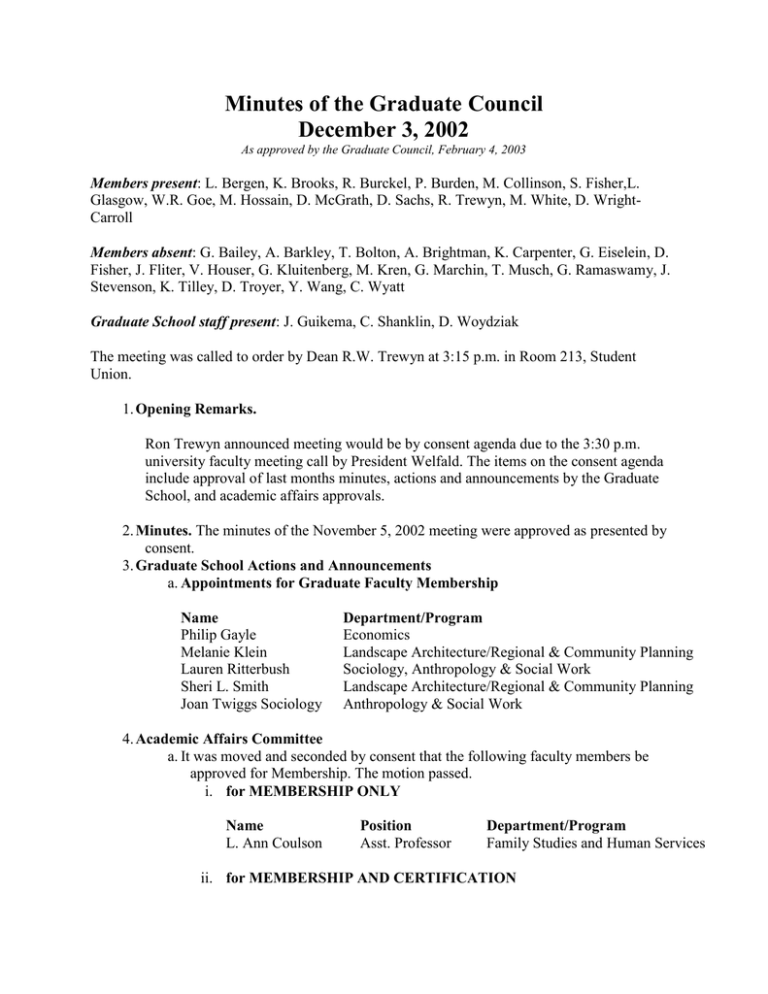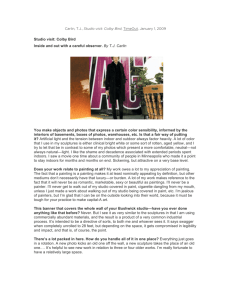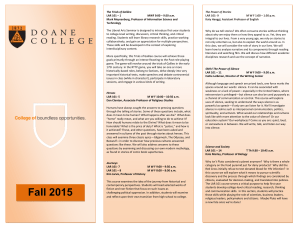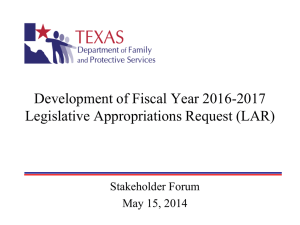Minutes of the Graduate Council December 3, 2002
advertisement

Minutes of the Graduate Council December 3, 2002 As approved by the Graduate Council, February 4, 2003 Members present: L. Bergen, K. Brooks, R. Burckel, P. Burden, M. Collinson, S. Fisher,L. Glasgow, W.R. Goe, M. Hossain, D. McGrath, D. Sachs, R. Trewyn, M. White, D. WrightCarroll Members absent: G. Bailey, A. Barkley, T. Bolton, A. Brightman, K. Carpenter, G. Eiselein, D. Fisher, J. Fliter, V. Houser, G. Kluitenberg, M. Kren, G. Marchin, T. Musch, G. Ramaswamy, J. Stevenson, K. Tilley, D. Troyer, Y. Wang, C. Wyatt Graduate School staff present: J. Guikema, C. Shanklin, D. Woydziak The meeting was called to order by Dean R.W. Trewyn at 3:15 p.m. in Room 213, Student Union. 1. Opening Remarks. Ron Trewyn announced meeting would be by consent agenda due to the 3:30 p.m. university faculty meeting call by President Welfald. The items on the consent agenda include approval of last months minutes, actions and announcements by the Graduate School, and academic affairs approvals. 2. Minutes. The minutes of the November 5, 2002 meeting were approved as presented by consent. 3. Graduate School Actions and Announcements a. Appointments for Graduate Faculty Membership Name Philip Gayle Melanie Klein Lauren Ritterbush Sheri L. Smith Joan Twiggs Sociology Department/Program Economics Landscape Architecture/Regional & Community Planning Sociology, Anthropology & Social Work Landscape Architecture/Regional & Community Planning Anthropology & Social Work 4. Academic Affairs Committee a. It was moved and seconded by consent that the following faculty members be approved for Membership. The motion passed. i. for MEMBERSHIP ONLY Name L. Ann Coulson Position Asst. Professor Department/Program Family Studies and Human Services ii. for MEMBERSHIP AND CERTIFICATION Name John Paul Michaud Position Assistant Professor Department/Program Entomology b. for CERTIFICATION Name Gerad D. Middendorf Robert Schaeffer Tracey M. Turner L. Susan Williams Position Assistant Professor Professor Assistant Professor Assistant Professor Department/Program Sociology, Anthropology & Social Work Sociology, Anthropology & Social Work Economics Sociology, Anthropology & Social Work c. Non-Graduate Faculty to teach Graduate Courses (One-Year Approval) Name Maria T. Melgarejo Department/Program Modern Languages Courses SPAN 751 Term Spring 2003 d. Course and curriculum changes: It was moved and seconded by consent to approve the following course changes, deletions, and additions. The motion passed. i. CHANGE: AGEC 836. Natural Resource Policy. (3) I. The economic tolls of welfare analysis, non-market valuation, and dynamics are used to evaluate natural resource use, natural resource policies, and conflicts among users, conservationists, and preservationists. Pr.: AGEC 505 or ECON 520; and MATH 205. AGEC 825. Natural Resource Policy. (3) I. The economic tolls of welfare analysis, non-market valuation, and dynamics are used to evaluate natural resource use, natural resource policies, and conflicts among users, conservationists, and preservationists. Pr.: AGEC 505 or ECON 520; and MATH 205. AGRON 645. Soil Microbiology. (4) I. The nature and function of soil microorganisms in the soil ecosystem. The role of soil microbial activity to soil organic matter, mineral transformations, plant nutrition, and environmental quality. Three hours rec. and two hours lab a week. Pr.:AGRON 305 or BIOL 455. AGRON 645. Soil Microbiology. (3) I. The nature and function of soil microorganisms in the soil ecosystem. The role of soil microbial activity to soil organic matter, mineral transformations, plant nutrition, and environmental quality. Three hours rec. a week. Pr.:AGRON 305 or BIOL 455. AGRON 900. Biometeorology. (3) II, in even years. A comprehensive analysis of interactions between living organisms and their physical environment. Emphasis is placed on AGRON 900. Biometeorology. (3) II. A comprehensive analysis of interactions between living organisms and their physical environment. Emphasis is placed on characterizing the transport of heat, water, and carbon within the soilplant-atmosphere continuum. Includes discussions on aerodynamics transfer, surface energy balances, evapotranspiration, trace gas fluxes, and basic micrometeorology. The potential impact of climatic change on biosphere productivity will be considered. Three hours rec. a week. Pr.: MATH 211 or MATH 220, PHYS 115, and AGRON 746 or BIOL 500. characterizing the transport of heat, water, and carbon within the soilplant-atmosphere continuum. Includes discussions on aerodynamics transfer, surface energy balances, evapotranspiration, trace gas fluxes, and basic micrometeorology. The potential impact of climatic change on biosphere productivity will be considered. Three hours rec. a week. Pr.:PHYS 115, and AGRON 746 or BIOL 500. AGRON 901. Environmental Instrumentation. (3) II, in odd years. A laboratory practicum on the methodology and instrumentation used to measure environmental parameters. Includes discussions on instrument selection, sensor deployment, and data acquisition. Measurement of temperature, radiation, moisture, wind, CO2 , and surface energy fluxes will be considered. Two hours rec. and two hours lab per week. Pr.: MATH 210 or MATH 220, PHYS 115, and AGRON 746 or BIOL 500. AGRON 901. Environmental Instrumentation. (1) II. A laboratory practicum on the methodology and instrumentation used to measure environmental parameters. Includes discussions on instrument selection, sensor deployment, and data acquisition. Measurement of temperature, radiation, moisture, wind, carbon dioxide. Two hours lab per week. Pr.:AGRON 900 or conc. enrollment. ART 395. Digital Photography. (3) I, II. Introduction to the principles and aesthetics of digital image processing. Hands-on activities will permit each student to explore the creative potential of electronic photography and imaging. Pr.: ART 386 and instructor permission. ART 611. Digital Photography and Advanced Techniques. (3) I, II. Introduction to the principles and aesthetics of digital image processing as well as continued exploration of chemical photography techniques. May be repeated for credit. Pr.: ART 400 and 572. ART 615. Figure Painting. (3) I, II. Painting from the human figure with oil and plastic media. Six hours lab. May be taken for two semesters. Pr.: ART 245, 610. ART 615. Figure Painting. (3) I, II. Painting from the human figure with oil media. Recording from direct observation with expressive concepts and feelings about the human form. Pr.: ART 225, 245. ART 620. Water Media II. (3) I, II. Upper-level painting with emphasis on individual expression in waterbased media, acrylic watercolor, gouache. Six hours lab. Pr.: ART 220. ART 620. Water Media II. (3) I, II. Advanced work in water-based media with emphasis on transparent watercolor. Six hours lab. Pr.: ART 220. ART 650. Oil Painting III. (3-6) I, II. Emphasis on individual directions in painting to attain personal expression and competency. Primarily for undergraduate painting majors. May be taken for four semesters. Pr.: ART 570 or 620. ART 650. Advanced Painting Studio. (3) I, II. Individualized studio work in varied painting media. Focusing on strengths and addressing weaknesses in personal work. Pr.: ART 649. ASI 801. Hormonal Control of Reproduction and Lactation. (3) I, in even years. Endocrine glands and their hormonal secretions that control reproduction and lactation in farm animals. Three hours rec. a week. Pr.:BIOCH 521 and ASI 710. ASI 801. Hormonal Control of Reproduction. (3) I, in even years. Basic study of endocrine physiology of reproduction including mechanism of hormone action through receptor and gene regulation, and physiological processes involved in ovarian, uterine, and testicular function. Three hours rec. a week. Pr.:BIOCH 521 and ASI 710. CS 726. Clinical Externship and/or Programmed Study. (Var.) I, II, S. Practical experience with the daily operation of veterinary practice, insights into the role of veterinarians in private industry, and/or opportunity to become involved in specialty areas relating to veterinary medicine in other academic institutions. Pr.:Fourth-year standing in the College of Veterinary Medicine. CS 726. Clinical Externship and/or Programmed Study. (1-3) I, II, S. Provides the professional student with the opportunity to study with specialists not available at Kansas State University or in unique areas of veterinary medical practice or research. Pr.:Fourth-year standing in the College of Veterinary Medicine and the approval of the externship or program of study by the course coordinator. HN 701. Sensory Analysis of Foods. (2-3) I. Sensory analysis of food appearance, texture, aroma, flavor; physiology of sensory receptors; laboratory and consumer panels; and interpretation of data. One hour rec. and three to six hours lab a week. Pr: STAT 320 or 330 or 340. HN 701. Sensory Analysis. (3) I. Sensory analysis of appearance, texture, aroma, flavor; physiology of sensory receptors; laboratory and consumer panels; and interpretation of data. Two hour rec. and three to six hours lab a week. Pr: STAT 320 or 330 or 340. LAR 646. Landscape Architecture Design Studio V. (4) I. Twelve hours of design studio a week. Pr.: LAR 442, LAR 438, LAR 439. LAR 646. Landscape Architecture Design Studio V. (4) I. The understanding, collection and application of land resource data to land planning and design. Current methods of resource inventory, ecologically oriented site analysis and environmental impact assessment. Three hours lecture and nine hours studio a week. Pr.: LAR 420, 442, 439. LAR 648. Landscape Architecture Studio VI. (4) I. Twelve hours of design studio a week. Pr.: LAR 646, 647. LAR 648. Landscape Architecture Design Studio VI. (4) II. Twelve hours of design studio a week. Design of the outdoor environment for human needs and activities; ecological considerations; project program, site selection, analysis concept, design communication, specification, construction, planting and maintenance. Pr.: LAR 646, 647. LAR 744. Community Site Planning. (4) II. Growth and development of cities and towns; land subdivisions. Two hours of lec. And six hours studio a week. Pr.: PLAN 315 or consent of instructor. LAR 744. Community Planning and Design. (4) I. Study of the relationships between planning and design in the growth and development of cities and towns. Two hours lec. And six hours studio a week. Pr.: PLAN 315. ii. DROP: ASI 605. Fresh Meat Operations. (2) I. Provides information and exposure to fresh meat operations, including: fabrication, yields, cost, quality assurance, packaging, marketing of fresh meat and by-products. One hour lec. and three hours lab a week. Pr.: ASI 350 BIOL 755. Specialized Cell Functions. (3) I, in even years. In vitro cell and organ culture techniques as tools for differentiation and specialization studies. Emphasis on mammalian cell culture systems with some study of plant cell culture. Pr.: BIOL 541. PLPTH 760. Plant Pathology Methods. (3) I, even-numbered years. Practical laboratory methods in manipulating plant pathogens with emphasis on the isolation, culture, identification, inoculation, and preservation of plant pathogenic bacteria and fungi. One hour lec. and 5 hrs lab a week. Pr.: PLPTH 500 or equivalent. Enrollment limited to 12 students. PLPTH 930. Genome Analysis. (3) II, in odd-numbered years. A discussion of the organization and evolution of genetic material in eukaryotic organisms. Methods of genetic and molecular analysis will also be discussed. Three hours lec. a week. Pr.: ASI 500; BIOL 540 or BIOCH 765. iii. NEW: AGEC 880. Agribusiness Industry Structures. (3) II. Applied industrial organization and competitive relationships in agriculture markets. Emphasis on the role of bargaining power, vertical coordination and integration, contracting, and other forms of vertical control. Product differentiation, branding and advertising of commodities and anti-trust laws. Three hours rec. a week. Pr.:ECON 720, ECON 830 (or concurrent enrollment). AGEC 925. Advanced Resource and Environmental Economics. (3) II. Dynamics analysis of natural resource and environmental problems, including the optimal extraction of nonrenewable resources, optimal management of renewable resources, and the optimal regulation of stock pollutants. Three hour rec. a week. Pr.:ECON 905, ECON 945. AGRON 646. Soil Microbiology Laboratory. (1) I. Discuss and perform laboratory procedures for enumerating soil microorganisms, quantifying soil biological activities, and nutrient cycling. Three hours lab a week. Pr.: AGRON 645 or conc. enrollment. ART 649. Painting Seminar. (3) I, II. Research studio work, and discussion focusing on painting movements of the last decade. Emphasis on painting and related media as visual language. Includes lectures, assigned readings, research presentations, and critiques of visiting artists in addition to studio work. Pr.: ART 570 or 572 or 615. ART 653. Senior Painting Studio. (3) I, II. Upper level focus on the exploration of painting media for personal expression. Emphasis on producing a cohesive body of work in preparation for the BFA exhibition. Pr.: ART 650. CHM 920. Analytical Separations. (3) II. The theory, instrumentation, methods, and applications of classical and modern separation techniques are covered in this lecture course. Pr.: CHM 566 and 595. CS 746. Clinical Equine Theriogenology. (3) II, S. Students will participate in the daily activities of the College's equine theriogenology practice both in-house and in the field. Routine procedures will provide an opportunity for students to develop their skills in handling horses, rectal examinations, ultrasonography, stallion semen collection, evaluation, artificial insemination, uterine therapies and minor surgical procedures. Postpartum and neonatal foal examinations will be performed. The student will have the opportunity to evaluate reproductive records on a breeding farm and acquaint him/herself with diverse management practices. Pr.: Fourth-year standing in the College of Veterinary Medicine or DVM Degree. LAR 655. Land Arch Internship, Part A. (10) II. Twenty-eight week internship with an approved landscape architecture, architecture, planning or engineering sponsor. Students are responsible for documenting their experiences in a bi-monthly report to the department. Must be enrolled concurrently with LAR 656. Pr.: LAR 646, LAR 647, and LAR 444. LAR 656. Land Arch Internship, Part B. (4) II. Preparation and presentation of internship report and employer profiles. Must be enrolled concurrently with LAR 655. Pr>: LAR 646, LAR 647, and LAR 444. LAR 700. Project Programming. (2) I. Research and the development of a program directed toward the advancement of a Capstone Project for LAR 704, Landscape Architecture Design Studio VII. Pr.: LAR 647 and LAR 648. 5. Graduate Student Affairs Committee The committee will save its report for the February meeting. 6. Graduate School Committee on Planning The committee will save its report for the February meeting. 7. Graduate Student Council Information The committee will save its report for the February meeting. 8. University Research and Scholarship The committee will save its report for the February meeting. 9. Other business Al Brightman presented a copy of a research ethics document created by the USDA. It was agreed to consider a KSU draft and to send the list to Academic Affairs for modification. 10. Discussion Ron Trewyn asked that if anyone has see or heard of large increases in assignments for graduate students (especially GTAs) to please bring the situation to his attention. There is concern due to budget issues and the trend towards reduction of graduate student appointments to relieve departmental financial stress. Council was adjourned at 3:25 p.m. K-State Home| Graduate School Home| Office of R



